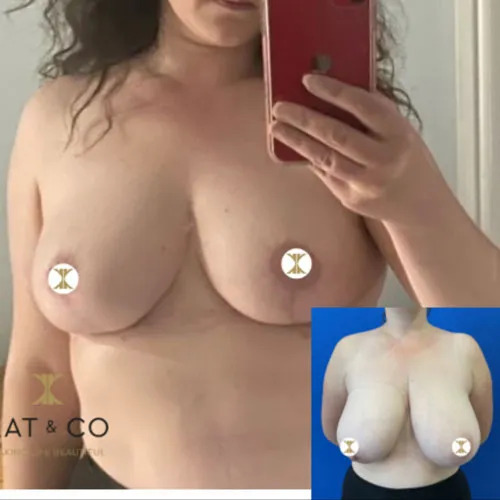.jpg)
When having breast reduction surgery, patients should expect some degree of scarring. The scars will vary depending on the technique used and the size of the breasts being operated on.
The amount of scarring also depends on the patient’s genetics, individual healing characteristics, and how well post-operative instructions are followed.
There are various techniques for breast reduction, and the most common scars depend on the method used, the individual patient, and the size of the breasts being reduced.
Most often, you can expect some scarring around the nipple, along the bottom of the breast fold, and a vertical scar connecting the nipple scar to the scar at the breast fold. This results in an ‘inverted T’ or anchor shaped scar. Some surgeons perform the procedure without the breast fold scar, resulting in only a vertical scar—this approach, known as the ‘vertical scar’ reduction, is usually reserved for smaller reductions and is not suitable for everyone.
If breast reduction is done using liposuction alone, there will only be minor scars under the arms, which are not visible. This approach is sometimes called ‘scarless breast reduction.’
It’s important to note that, in addition to aiming for the best surgical results, plastic surgeons strive to minimize scarring and often place incisions where they will be less noticeable. Scars typically improve over time and become less visible.
All patients at Kat & Co have access to advanced scar minimisation support after breast reduction surgery.
Breast reduction surgery uses several main incision types, each producing distinct scarring patterns. Your surgeon will recommend the most suitable option during your consultation, taking into account your needs and whether the procedure is medically necessary.
.jpg)
Breast reduction scars will not disappear completely, but with our skilled surgeon's techniques and proper after-care, scarring can be kept to a minimum.
To help minimise scarring, it is essential to follow all after-care instructions. Avoid smoking, tanning, excessive scrubbing, and scratching the area, as these actions can worsen the appearance of scars.

.jpg)
.jpg)

Breast reduction scar healing varies for each person, but most follow a general pattern as the scars mature and fade.
After 3 Weeks
Incision sites are still covered with dressings and bandages. At this stage, focus is on immediate recovery—resting, keeping the incisions clean, and avoiding strain on healing tissue.
After 1 Month to 6 Weeks
You enter the healing phase where swelling and bruising remain noticeable. Incisions will look red and fresh. It is important to continue resting, avoid strenuous activities, and keep scars out of direct sunlight.
After 2 Months
The scar maturation phase begins and lasts about 6 months. Scars start fading as redness diminishes and skin tone evens out. Raised scars from surgery begin to flatten and become flush with natural skin.
After 6 Months
In this intermediate phase, scars should appear more mature and less visible, blending better with surrounding skin. Gentle massage of scars may be recommended.
After 1 Year
Scars continue maturing but will not completely disappear. They typically become faint and much less noticeable to the naked eye, with gradual improvements over time.
This timeline reflects the usual progression, though individual healing speeds and scar appearance may vary.
How Long Do Scars Last After Breast Reduction Surgery?
Scars from breast reduction surgery appear as thin, raised lines on the skin. As they heal, scars usually darken and then flatten. It can take several months up to a year for scars to fade. People with darker skin tones have a higher risk of developing hyperpigmentation or thicker, raised scars.
How Do You Reduce Scar Tissue After Breast Reduction?
After surgery, patients should wear a compression garment day and night for about three weeks, sometimes up to six to eight weeks. This protects the wounds and supports healing. Gentle scar massage techniques may also be recommended to reduce scar tissue. Access to advanced scar minimisation programs with expert support can further aid the healing process[previous conversation].
What is a Short Scar Breast Reduction?
Short scar breast reduction uses smaller incisions concentrated on the lower half of the breasts, making scars less noticeable and easy to hide under clothing. It is typically suitable for women seeking mild to moderate reductions or those with sagging breasts. This technique is less effective for larger reductions[previous conversation].
Are There Any Alternative Breast Reduction Scar Treatments?
Alternative treatments include topical scar creams and gels, silicone gel sheets, bio-oil massage, laser therapy, cortisone injections for raised scars, and microneedling to improve scar texture and appearance. The effectiveness of these varies by individual, and your surgeon can recommend the best options post-surgery[previous conversation].
Are Breast Reduction Scars on Dark Skin Any Different?
Yes, darker skin tones are more prone to hyperpigmentation, hypertrophic scarring, and keloid formation, although these are uncommon. Rigorous post-operative scar care such as massage and sun protection is especially important for darker skin to manage scarring effectively[previous conversation].
What is the General Timeline for Breast Reduction Scar Healing?
What Factors Influence Scar Healing and Appearance?
If you need more information on your specific situation or scar management options, consulting your surgeon or scar care specialist is recommended. Contact Us to Book your Breast Reduction Consultation
